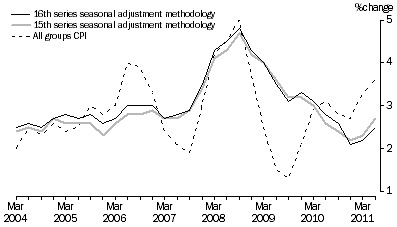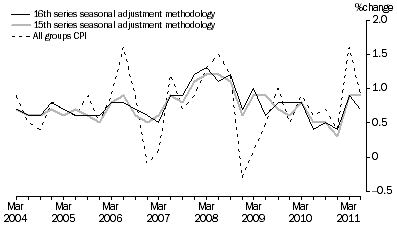TRIMMED MEAN AND WEIGHTED MEDIAN MEASURES OF INFLATION
4.1 The Trimmed mean and Weighted median series are part of the suite of analytical measures of the CPI. They aim to remove volatility observed in the quarterly price change of the CPI caused by large, irregular price movements to estimate the underlying trend inflation. In calculating underlying trend inflation measures, previous analysis by the RBA found seasonal adjustment “reduces the chance that a highly seasonal item will be trimmed from the distribution of price changes, providing that inflation over the year in that item is not significantly greater than overall CPI inflation" (Roberts, 2005).
4.2 A detailed explanation of the calculation of the Trimmed mean and Weighted median underlying trend measures, is shown in Appendix 3, together with a worked example.
4.3 In summary, the Trimmed mean and Weighted median are calculated using a distribution of expenditure classes derived as follows:
- The CPI expenditure classes are ranked from lowest to highest according to the seasonally adjusted percentage change from previous quarter.
- The seasonally adjusted relative weight of each expenditure class is calculated based on its previous quarter contribution to the All groups CPI.
- The Trimmed mean is calculated using a weighted average of percentage change from previous quarter (seasonally adjusted) from the middle 70 per cent of the distribution.
- The Weighted median is calculated using the percentage change from previous quarter (seasonally adjusted) expenditure class at the 50th percentile of the distribution.
4.4 The Trimmed mean and Weighted median account for regular seasonal movements and exclude, through the trimming out process, expenditure classes showing irregular movements based on their movements within each quarter. For example, the ‘Tobacco’ expenditure class is generally considered to be a stable index. However policy changes, such as the increase in excise tax, can result in large, irregular movements, which can influence the original CPI figure. In the June quarter 2010, the ‘Tobacco’ expenditure class recorded a 15.4% rise, predominantly due to a one off increase in excise tax. This resulted in this expenditure class recording the highest quarterly percentage change of the 90 expenditure classes contributing to the All groups CPI for June quarter 2010. The ‘Tobacco’ price index was excluded (trimmed out) when calculating the underlying trend measures of inflation in the June quarter 2010, due to the large movement shown in that quarter. Graph 4 depicts the percentage change from previous quarter for the Tobacco price index at the weighted average of eight capital cities level.
GRAPH 4: TOBACCO PRICE INDEX, Weighted average of eight capital cities - Percentage change from previous quarter
IMPACT OF USING ABS SEASONAL ADJUSTMENT METHODOLOGY ON TRIMMED MEAN AND WEIGHTED MEDIAN
4.5 The following graphs (Graphs 5 – 8) compare the percentage change from corresponding quarter of previous year and percentage change from previous quarter for the Trimmed mean or Weighted median using the 15th and 16th series seasonal adjustment methodologies and the All groups CPI where the:
- 16th series seasonal adjustment methodology (standard ABS seasonal adjustment) is the Trimmed mean or Weighted median using seasonal adjustment on 64 out of the 90 expenditure classes.
- 15th series seasonal adjustment methodology is the Trimmed mean or Weighted median using seasonal adjustment on 20 out of the 90 expenditure classes.
- All Groups CPI is the All groups CPI, weighted average of eight capital cities.
GRAPH 5: TRIMMED MEAN, Percentage change from corresponding quarter of previous year

GRAPH 6: TRIMMED MEAN, Percentage change from previous quarter

GRAPH 7: WEIGHTED MEDIAN, Percentage change from corresponding quarter of previous year
GRAPH 8: WEIGHTED MEDIAN, Percentage change from previous quarter
4.6 Graphs 5 – 8 show that moving to the 16th series seasonal adjustment methodology slightly increases the percentage change from the corresponding quarter of previous year in most (although not all) quarters, for both the Trimmed mean and Weighted median. Analysis found the differences were primarily due to the inclusion of ‘Automotive fuel’ and ‘Hospital and medical services’ as seasonal expenditure classes under the 16th series seasonal adjustment methodology. Seasonal adjustment reduces their volatility and reduces the chance that these expenditure classes will be trimmed from the distribution of price changes.
4.7 For further information on the measures of underlying trend inflation, please see 'Underlying Inflation: Concepts, Measurement and Performance', Reserve Bank of Australia Research Discussion Paper No 2005-05 (Roberts, 2005), available at
<http://www.rba.gov.au/publications/rdp/index.html>.
 Print Page
Print Page
 Print All
Print All